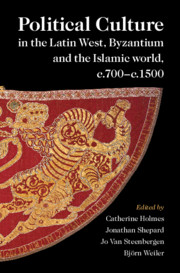 Political Culture in the Latin West, Byzantium and the Islamic World, c.700–c.1500
Political Culture in the Latin West, Byzantium and the Islamic World, c.700–c.1500 Book contents
- Political Culture in the Latin West, Byzantium and the Islamic World, c.700–c.1500
- Political Culture in the Latin West, Byzantium and the Islamic World, c.700–c.1500
- Copyright page
- Contents
- Figures and Maps
- Contributors
- Preface and Acknowledgements
- Abbreviations
- General Maps
- 1 Political Culture in Three Spheres
- 2 Reflections on Political Culture in Three Spheres
- Part I Sources
- Part II Historical Contexts
- Part III Norms, Values and Their Propagation
- Part IV Practice and Organisation
- 13 The Latin West
- 14 Byzantium
- 15 The Islamic World
- Part V Conclusions
- Appendix
- Glossary
- Index
14 - Byzantium
‘To Have and To Hold’ – The Acquisition and Maintenance of Elite Power
from Part IV - Practice and Organisation
Published online by Cambridge University Press: 11 August 2021
- Political Culture in the Latin West, Byzantium and the Islamic World, c.700–c.1500
- Political Culture in the Latin West, Byzantium and the Islamic World, c.700–c.1500
- Copyright page
- Contents
- Figures and Maps
- Contributors
- Preface and Acknowledgements
- Abbreviations
- General Maps
- 1 Political Culture in Three Spheres
- 2 Reflections on Political Culture in Three Spheres
- Part I Sources
- Part II Historical Contexts
- Part III Norms, Values and Their Propagation
- Part IV Practice and Organisation
- 13 The Latin West
- 14 Byzantium
- 15 The Islamic World
- Part V Conclusions
- Appendix
- Glossary
- Index
Summary
This chapter is principally concerned with the relationship between central and local power in Byzantium. It focuses on the resources and structures characterising political elite membership, particularly land, public offices and salaries, kinship, networks, status and display. From a mainly provincial perspective, it examines changes over time in the possessions and political horizons of elites, taking note of the roles of monasteries, villages and commerce. Considerable attention is paid to the polycentric Byzantine world of the later period, which continued until, and in some cases beyond, the Ottoman conquest of Constantinople in 1453 and involved polities beyond the Palaiologan dynasty. While much about Byzantine political practice changed between 700 and 1500, the post-1204 evidence reveals the long-term importance of the local to power in Byzantium, a state of affairs often hinted at in earlier periods but only rarely visible in the surviving sources.
- Type
- Chapter
- Information
- Political Culture in the Latin West, Byzantium and the Islamic World, c.700–c.1500A Framework for Comparing Three Spheres, pp. 410 - 455Publisher: Cambridge University PressPrint publication year: 2021
